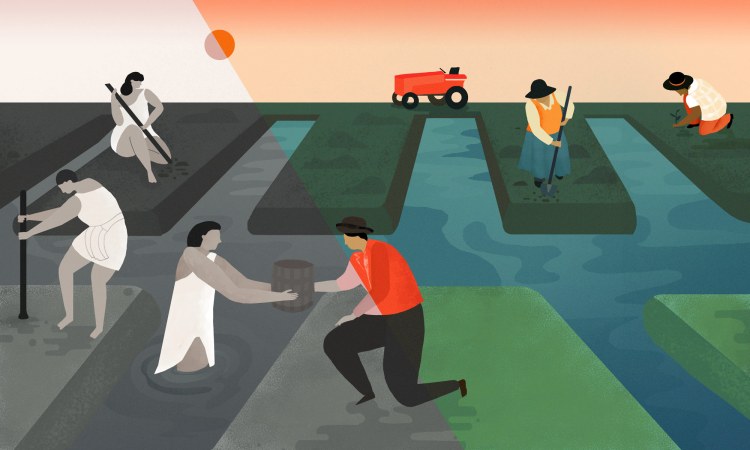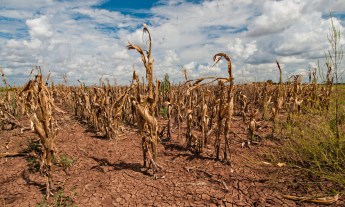
Who says you can’t solve today’s problems with yesterday’s solutions? Check out these four innovative, ancestor-approved approaches
Extreme weather has become the norm across the globe, in large part thanks to climate change, and it’s playing havoc with farmers and ranchers who depend on predictable weather to grow our food. But while some growers are turning to new technology to adapt to this strange new weather, some farmers are looking backward, exploring old ideas that once worked and might again. As Keith Alverson, an expert at the United Nations Environment Programme, explains, there’s probably no “silver bullet that would solve everything,” but it’s important to look both forward and backward to develop a wide set of tools as we adapt. Below are four examples of old ideas — some going back 2,400 years — that are finding new relevance in the 21st century.
Rediscover ancient grains. Floods are a part of life in the Mekong Delta in Vietnam. But now they’re occurring with greater frequency and intensity, swamping and destroying rice and other essential crops. The conventional approach to floods has been to build dykes around rice paddies; instead, Nguyen Van Kien wants to remove such barriers altogether. Nguyen, a postdoctoral research fellow at the Australian National University, has been showing farmers in his country how to work with floods by planting a local rice variety called “floating rice.” It was widely grown in the region for years until it was replaced in the 20th century by high-yield rice (which produces four times the output).
“Floating rice is well adapted to floods,” Nguyen says. When heavy rains come, the plants grow at an accelerated rate so their foliage always remains above water — they can reach up to six meters (20 feet) in height. And since floodwaters can safely fill floating-rice paddies rather than swelling the river, the cities and villages downstream escape being submerged. “When we first reintroduced floating rice to the village of Vinh Phuoc in 2013, nearby farmers wanted us to teach them as well,” Nguyen says. His team is running a pilot program in two provinces in the Mekong Delta, and they plan to launch field work in Cambodia and Myanmar next year.
Study ancient archaeology to see how ancestors coped with drought. In 2000, Oscar Saavedra, then a college student in Bolivia, began searching for ways to counter climate change’s devastating effects on crops. He realized that ancient people in the Bolivian Amazon suffered from the same problems as today’s farmers: periods of flooding followed by drought, and soil with low fertility. He studied archaeological remains dating back to 400BC and borrowed a past strategy. It works this way: Camellones — elevated fields of up to two meters (7 feet) high — are constructed to stand above the height of floodwaters, and surrounded by canals. During the rainy season, the canals hold floodwater, preventing crops on the camellones from being washed away. The nutrient-rich canal water can later be used to irrigate the camellones during droughts. Since Saavedra experimented with the method in the Beni region in 2007, he’s seen good results: His cassava and corn harvests set new records for organic farming in the area. When severe floods came in 2008 — the worst Bolivia had seen in 50 years — the plants on the camellones were the only ones that survived. The crops in conventional fields were completely swamped and destroyed. Although the intensive labor required to construct a camellone — it takes a week’s work with machinery for each hectare — has deterred some farmers, Saavedra’s nonprofit organization Sustainable Amazonia has taught 500 families to use this method. Oxfam has endorsed the camellone technique and financed its development in Bolivia.
Return to an old social order. The Borana, a cattle-herding tribe in Kenya, is surviving droughts in arid Isiolo County by reintroducing an abandoned, centuries-old traditional grazing management method. Called “Dedha” (which means “council” in the local dialect), the system relies on placing decision-making authority in the hands of the elders who have the most experience in grazing and watering cattle. By planning for the community as a whole, these elders ensure that all herders have adequate pasture and water for their animals. Since Dedha was reinstated in 2011, the Borana have lost fewer animals to drought, according to Victor Orindi of the Adaptation Consortium, a group that works to mitigate the effects of climate change in Kenya. Conflicts over natural resources have also been reduced, he adds. The county is in the process of passing legislation that will officially recognize the authority of Dedha councils.
Instead of pesticides, try … ducks. While new techniques have helped battle the impact of global warming, success has sometimes come at a price. One example is in northern China’s Heilongjiang Province. There, chilly springs used to hold back the hatching of pests. But with rising temperatures, that delay is fading away and pests are proliferating. Many farmers turned to intensive pesticide use, which has saved their crops — but killed large amounts of wildlife. “I was in a village where there were no frogs and no swallows. Instead, I saw empty pesticide bottles everywhere,” says Fang Yongjiang, a Chinese farmer and entrepreneur in the province. “The village was so quiet that it was scary.”
So Fang devised a chemical-free approach: using ducks to patrol the rice paddies, a technique that his ancestors relied on at least 600 years ago. The ducks feed on insects and weeds without consuming the rice plants; their droppings serve as fertilizer. He has added a modern twist: he also spreads beneficial microbes that release nutrients to enrich the soil and fight against harmful microbes, reducing plant disease. As a result, his rice paddies are both pesticide- and fertilizer-free, Fang says. Since organic rice is a desirable commodity in China, he can sell his harvest for three times as much as conventional rice. In 2014, Fang began experimenting with ducks on 25 acres. Two years later, other rice growers in the region have followed suit, leading to a total of nearly 500 duck-patrolled acres.











